Whether you’re the owner of an established brick and mortar bakery or you’re just getting started, an online bakery website is a great way to reach new customers. And, as you’ll find out in this post, it’s easier than ever to get started.
In this article, we’ll show you how to build an online bakery website in just seven super fast steps.
Before we get to the tutorial, let’s briefly discuss why creating a bakery website is a fantastic idea.
Why your bakery business needs a website
There are several reasons why your bakery business needs a website.
A website gives you an opportunity to showcase your products and services in a professional manner. With potential customers able to view your website 24/7, it’s a great way to promote your business around the clock.
Having a bakery website can also help you reach a wider audience.
Not only can people from your local community view your website, but people from all over the world can learn about your business and place orders online.
Finally, a bakery website can help boost sales and grow your business.
With an online ordering system, customers can easily purchase your products without having to visit your bakery in person.
How to sell baked goods online
So you’re convinced that setting up a bakery website is a good idea — great!
But you should know starting a food-based business can be a bit tricky, especially if you go into it without knowing the laws and regulations currently surrounding the industry.
To get started, here are a few things you need to do to sell baked goods online:
- First, check with your local city to see if there are any restrictions in place for selling food products online. There are cottage food laws in the United States, for example, that allow people to sell certain types of food products from their homes without having to obtain a commercial kitchen license, but it varies widely from region to region.
- Next, you’ll need to decide what type of bakery products you want to sell online. If you plan on shipping products, prioritize those that are shelf stable. If you’re merely booking services online but providing local delivery or pickup, then this won’t be an issue.
- Make sure you have the proper permits and licenses in place before beginning operations. This applies to starting up any sort of business, so look up the permitting and licensing rules before you begin.
- Once you have the green light from your local authorities, it’s time to start thinking about packaging and shipping. When shipping food products, it’s important to use a reliable and insulated shipping method to ensure the items arrive fresh and in one piece.
- Storage is a necessity as well. Again, if shipping products, you’ll need ample refrigeration storage space to keep your ingredients fresh as well as racks, shelving, and bins to store shipping and packaging materials.
With these preparatory steps out of the way, it’s time to get down to the business of making a bakery website.
How to create a bakery website
The process of building a bakery website has never been easier, thanks to ready access to bakery website builders and a plethora of easy-to-use tools.
Step 1: Choose web hosting and set up WordPress
The first step in creating your bakery website is to choose web hosting and set up WordPress.
For those unfamiliar with web hosting, it’s a service that stores all the files and data associated with your website and makes it accessible to people all over the world via the internet.
There are many different web hosting companies to choose from, but we recommend using SiteGround or Cloudways.
These are both reputable companies that offer excellent features and customer support.

Once you’ve chosen a web host, setting up WordPress is a breeze.
Most web hosting providers offer a one-click install option. This makes the process as simple as literally clicking ‘install’ and sitting back as WordPress is automatically installed on your server.
Step 2: Install a WordPress theme
The next order of business is to install a WordPress theme. A WordPress theme is a predesigned template you can use to change the look and feel of your website with just a few clicks.
There are thousands of WordPress themes to choose from, both free and premium.
For bakery websites, we recommend using the Astra WordPress theme, which provides a wide range of options for creating a beautiful and functional bakery website.

You’ll get off to an even better start by choosing a bakery website template. This will give your site the structure and layout of a bakery website or online store without you having to design a thing.
Recommended Astra’s templates:
Cake Shop is a lovely option with full-width sliders, pull quotes, and bold images.
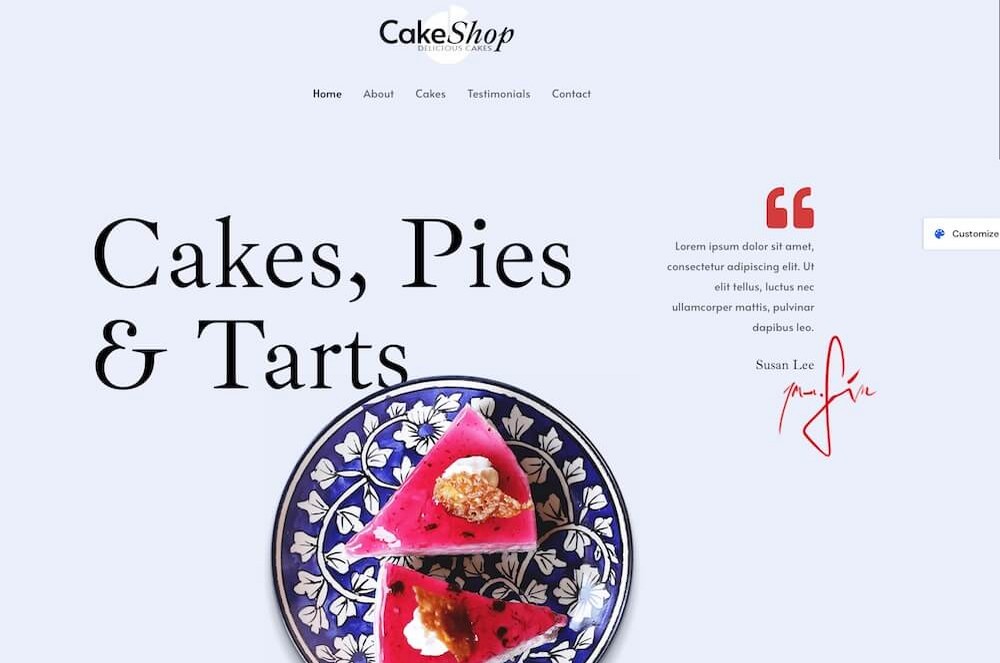
Or you might wish to opt for Sweet Shop, which offers a solid combination of visually-appealing designs and eCommerce-ready features.
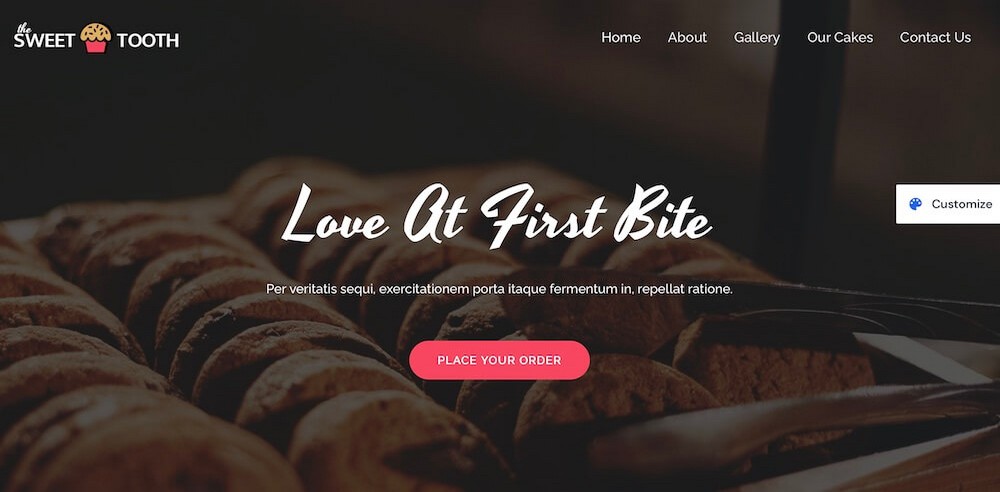
To get started with using Astra, purchase and download the WordPress theme then log in to your WordPress dashboard.
On the left-hand side of the screen, hover over Appearance then click Themes. At the top of the next page, click Add New.
Click Upload Theme, then Choose File.
Select the .zip file you downloaded, then click Install Now.
Finally, click Activate to make Astra active on your website.
To use a Starter Template, you’ll need to install the Starter Templates plugin.
To do this, go to Plugins > Add New then search for “Starter Templates.”
Once you find the plugin, click Install then Activate.
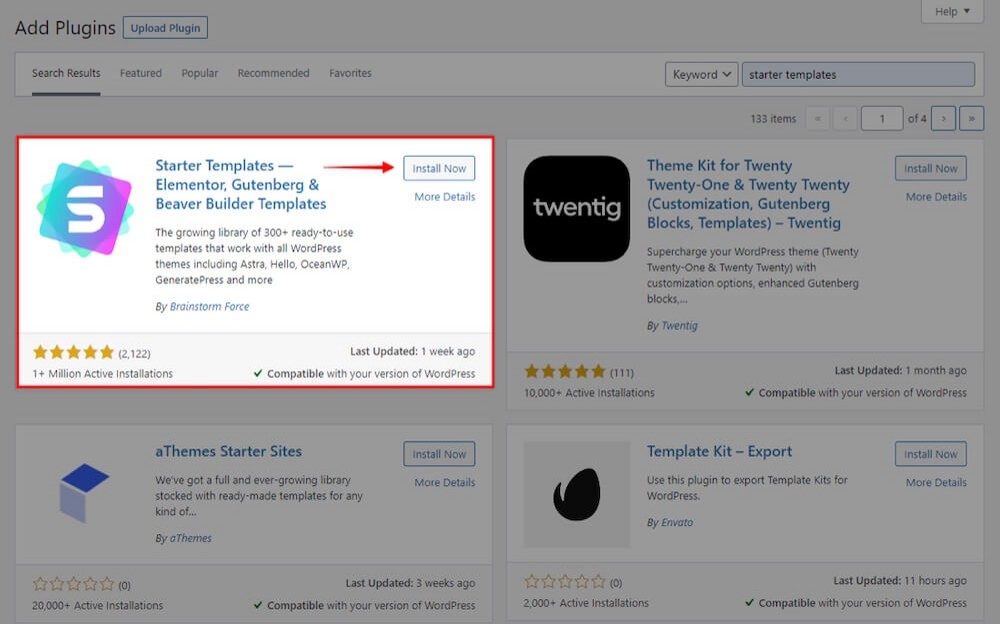
Once activated, go to Appearance > Starter Templates.
This will give you access to all of the free Starter Templates Astra currently has available and you can import them directly into your website this way.
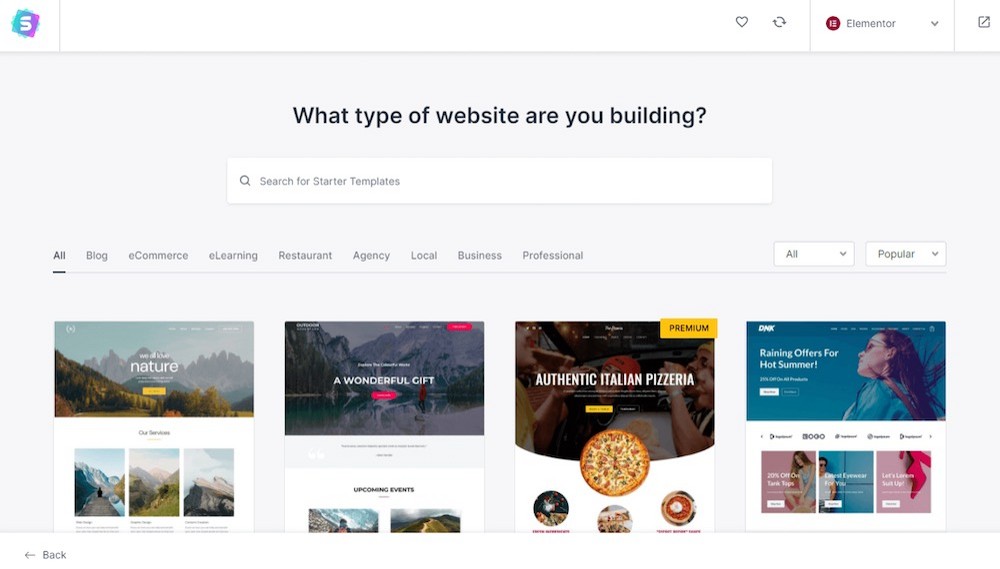
The previously mentioned Starter Templates (Cake Shop and Sweet Shop) are premium Starter Templates.
To access these, you’ll need to purchase the Essential Toolkit or Business Toolkit, which includes Astra Pro, plus premium Starter Templates, as well as additional plugins and premium support.
Once purchased, you can access the Premium Starter Templates plugin on the Brainstorm Force store, then go to Account > Downloads, and download the plugin as a .zip file.
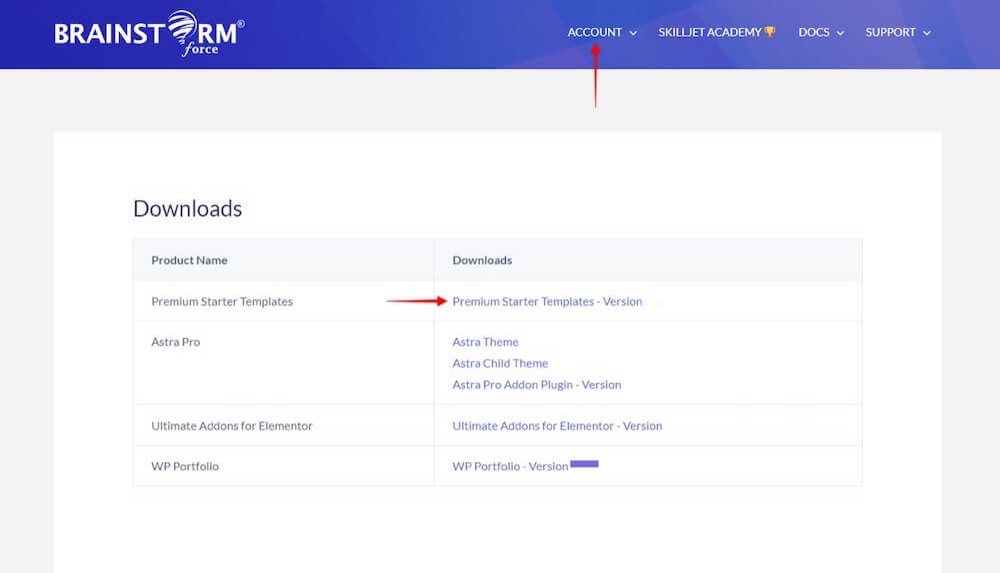
Upload the plugin as you would normally to WordPress then go to Account > Licenses in the Brainstorm Force store and copy your plugin license.
Back in WordPress, navigate to Plugins then find the Premium Starter Templates plugin in the list of installed plugins.
Click the green Activate License link and paste your copied plugin license.
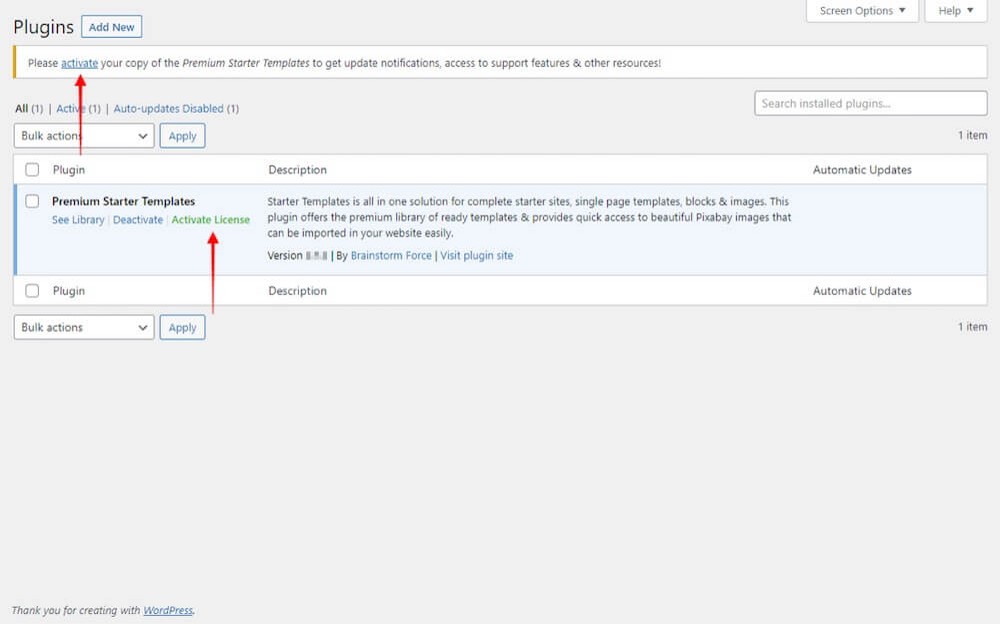
After this, you can follow the same procedure as you did with the free Starter Templates plugin to find and install a template you wish to use.
Step 3: Use WooCommerce to sell bakery products
Now that you have a WordPress theme installed, it’s time to start thinking about how you’re going to sell bakery products online.
The easiest way to do this is by using the WooCommerce plugin.

WooCommerce is a WordPress plugin that turns any WordPress website into a fully-functional online store. It’s free to use and comes with a wide range of features, making it the perfect solution for selling bakery products online.
Some of the key features of WooCommerce include:
- The ability to sell physical and digital products
- Integrated payment gateways
- Automatic tax calculations
- Shipping options
- Inventory management
To install WooCommerce, head over to the Plugins section of your WordPress dashboard and search for “WooCommerce.”
Once you’ve found it, click Install and then Activate.

You can then individual product listings to your online store by going to Products > Add New in your WordPress dashboard.
Here you can add a product name, description, price, images, and other relevant information.
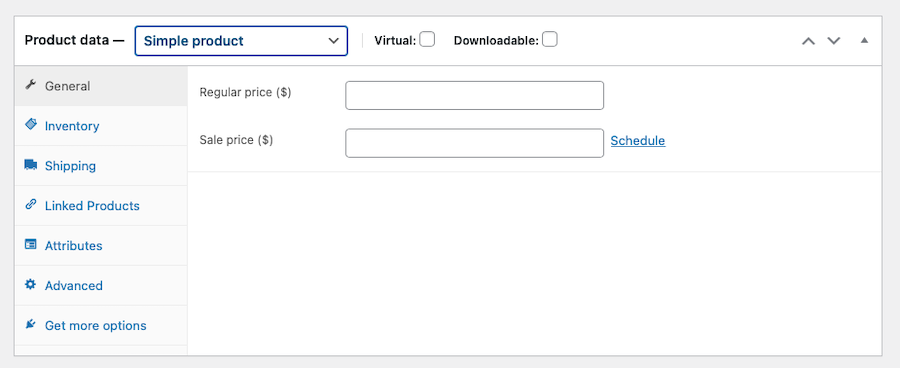
Once you’re happy with your product listing, simply click Publish to make it live on your website.
Step 4: Set up CartFlows to create sales funnels
If you want to sell bakery products online, you may want to create a sales funnel. A sales funnel is a journey that leads a potential customer from awareness to purchase.
The best way to create a sales funnel is by using the CartFlows plugin.
Cartflows is a WordPress plugin that allows you to create sales funnels and checkout pages with ease.

Some of the key features of CartFlows include:
- The ability to create one-click upsells and downsells
- A wide range of templates and themes
- Integration with popular payment gateways
- A/B testing feature
To install CartFlows, head over to the Plugins section of your WordPress dashboard and search for “Cartflows.”
Once you’ve found it, click Install and then Activate.
You can then create your first sales funnel by going to CartFlows > Add New in your WordPress dashboard.
Here you can give your sales funnel a name, choose a template, and then start adding the individual steps that will make up your funnel.
For instance, if you want to create a free bakery order form template, you can do so by utilizing a store checkout “flow.”
A flow is CartFlows’ name for a sales funnel.
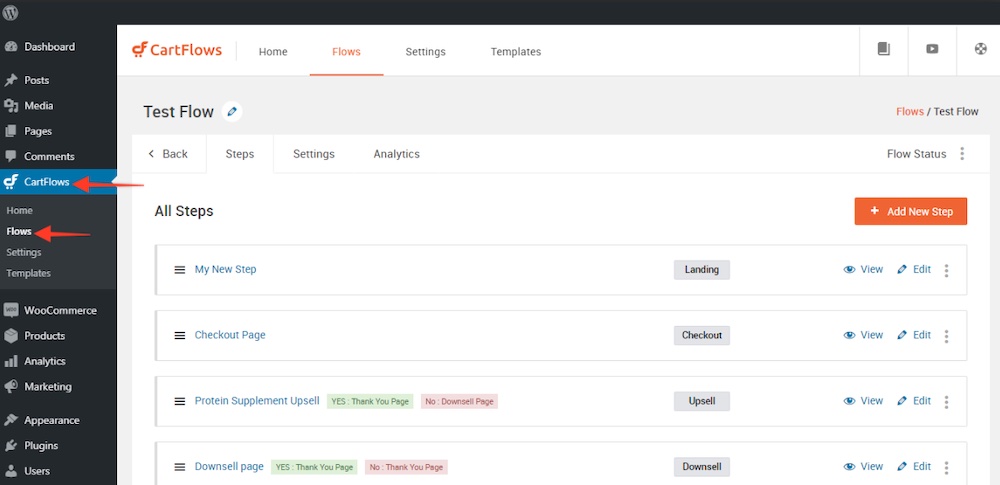
You can customize the steps presented here to suit your business.
If you need to collect details about what the customer would like to appear on a custom cake, you can create a flow that requests this information without overwhelming potential customers.
When you’re happy with your sales funnel you can integrate it directly with your WooCommerce store to streamline the checkout process.
Step 5: Create bakery pages
Now that you have a WordPress theme and plugins installed, WooCommerce installed and configured and CartFlows ready to go, it’s time to start creating the foundational pages of your bakery website.
To create a new page, simply go to Pages > Add New in your WordPress dashboard.
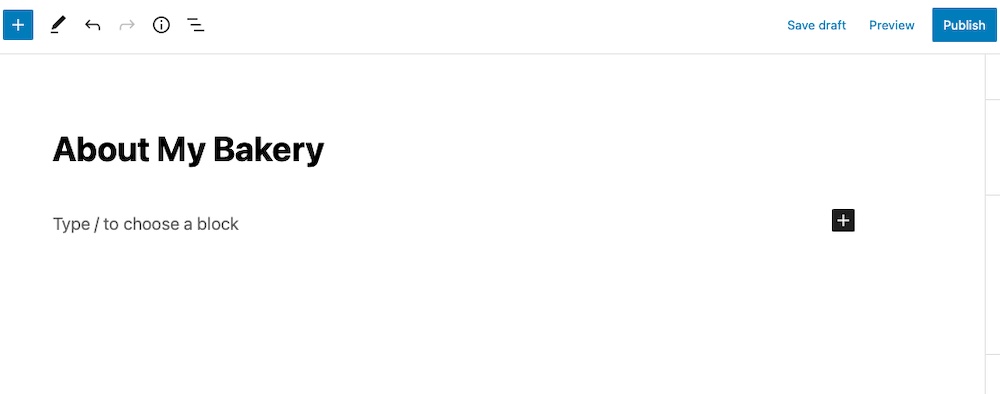
You can then give your page a title, add content, and insert images and other media. Bakery websites most often should include the following pages:
Homepage
A homepage is the first page that visitors will see when they arrive at your bakery website. It should give visitors an overview of your bakery, what you sell, and how to order bakery products.
It should also include:
- Your operating hours (including relevant holiday information)
- The number of days required in advance to book your services
- A highlight of the locations you serve or a radius you cater to
As a local business, it’s vital you make it clear upfront what areas your bakery will cater/deliver to and when you’ll be available.
About
An about page is a great way to introduce yourself, your bakery, and your team. This is an opportunity to share your story, describe your process, and highlight any awards or accolades you’ve received.
It’s also a great place to showcase any press coverage you’ve had.
Products page/menu
A bakery menu page should list all of the products you offer along with pricing information. If you offer custom cakes or other bakery products, then you can use this page to showcase some of your previous work.
Services page
This page should offer a few examples of custom services you provide (if applicable) like made-to-order cakes for events or weddings.
Contact page
A bakery contact page should include your bakery’s phone number, email address, and physical address (if you have one).
It should also include a contact form so that potential customers can easily get in touch with you.
It’s also a good idea to repeat some of the information touched upon on the homepage here like your operating hours, number of days to book in advance, and the service area radius you cater to. Here are a few contact form plugins you can use to create a form on your online bakery website.
Policies page
A bakery policies page should include your refund policy, terms and conditions, and any other important information potential customers need to know.
Privacy policy
You should also have a separate privacy policy page that outlines how you collect, store, and use customer data.
Blog
A bakery blog is a great way to share recipes, baking tips, and other relevant information with your audience. It can also help you attract new customers and drive traffic to your bakery website.
Publishing new search engine optimized content regularly can help to boost your site’s ranking, so it’s definitely worthwhile.
Step 6: Install helpful bakery plugins
In addition to the WordPress bakery themes and plugins we’ve already mentioned, there are a few other types of plugins that can add greater functionality to your website.
Here are a few plugin types to consider (along with a handful of suggestions for each):
- Page builders: We’ve mentioned Astra as a standout WordPress theme to use, but you’ll need a page builder to make the most of it. Astra works with Elementor, Beaver Builder, as well as the built-in Gutenberg WordPress block editor.
- Form builder: To take orders online, you’ll need a form builder plugin to help you create order forms and other types of forms for your bakery website. We recommend WPForms or Gravity Forms. CartFlows can assist in adding WooCommerce-integrated forms as well.
- Gallery/portfolio plugins: If you plan to showcase bakery photos or other types of images on your website, you’ll need a gallery plugin to help you create image galleries or portfolios. We recommend WP Portfolio Plugin for best displaying your items.
- SEO plugins: To help improve your bakery website’s search engine optimization (SEO), we recommend the SEOPress and Schema Pro plugins.
- eCommerce plugins: Besides WooCommerce, it’s also a good idea to use additional eCommerce-focused plugins to expand the features available to you. If you plan on selling bakery products online, Variation Swatches for WooCommerce can help you create product variations and display them in a visually appealing way.

Once you’ve added the plugins you want to use, it’s time to focus on building greater awareness for your bakery.
Step 7: Market your bakery
With your bakery website built and launched, it’s time to start marketing your bakery and driving traffic to your site.
There are a number of ways you can market your bakery online. Here are just a few ideas to get you started:
- Create a blog and share recipes, baking tips, and other relevant information.
- Use social media to share photos of your bakery products and drive traffic to your website.
- Use email marketing to promote special offers and drive traffic to your website.
- Create a newsletter and share it with your customers and potential customers.
- Use SEO to make sure your bakery website appears in the search engine results pages (SERPs).
- Use Google AdWords or other pay-per-click (PPC) advertising to increase site traffic.
- Set up a Google Business Profile and encourage customers to leave reviews.
- Give away free samples of your bakery products to those who drop in to entice them to make a purchase.
- Sponsor a local event or bake sale to get your bakery’s name out there.
- Give a percentage off to customers who mention a secret code word you share on social media when they make a purchase in-store.
- Participate in local fairs or festivals to sell your bakery products.
By following these steps, you can create a professional bakery website that will help you sell more bakery products and attract new customers.
Frequently Asked Questions
Now that we’ve gone through the entire tutorial, let’s answer some frequently asked questions about bakery websites.
What is the best page builder for bakeries?
The best page builder for bakeries will depend on your specific needs and requirements. However, some of the best bakery page builders include Elementor, Beaver Builder, and Gutenberg.
Do I need a bakery website?
While you don’t technically need a bakery website, having one can help you sell more baked goods and attract new customers. A bakery website can also help you build brand awareness and establish your bakery as a professional business.
How much does it cost to build a bakery website?
The cost of building a bakery website will depend on a number of factors, including the website builder you use, the hosting plan you choose, the bakery plugins you install, and whether or not you hire a professional to help you with the website build. In general, you can expect to pay anywhere from $25 to $150 to build a bakery website yourself, which includes the cost of hosting, a domain name, a moderately-priced WordPress theme, and a premium plugin or two.
How can I market my bakery website?
There are a number of ways you can market your bakery online. A few ideas include: creating a blog and sharing recipes, using social media to share photos of your bakery products, using email marketing to promote special offers, creating a newsletter and sharing it with your customers, and using SEO to make sure your bakery website appears in search.
What WordPress theme is best for creating a bakery website?
There are a number of bakery WordPress themes available, but Astra is one of the best. Astra is a lightweight WordPress theme perfect for creating bakery websites. It includes a number of features well-suited to building an online store.
Wrapping up
Creating a bakery website is a great way to sell more bakery products and attract new customers. By following these seven super fast steps, you can have a professional bakery website up and running in no time!
And don’t forget, Starter Templates for Astra make for the perfect pairing to get your website off the ground. Good luck!
Have you created a bakery website recently? Have any tips to share to help others? Tell us your story below!
Disclosure: This blog may contain affiliate links. If you make a purchase through one of these links, we may receive a small commission. Read disclosure. Rest assured that we only recommend products that we have personally used and believe will add value to our readers. Thanks for your support!
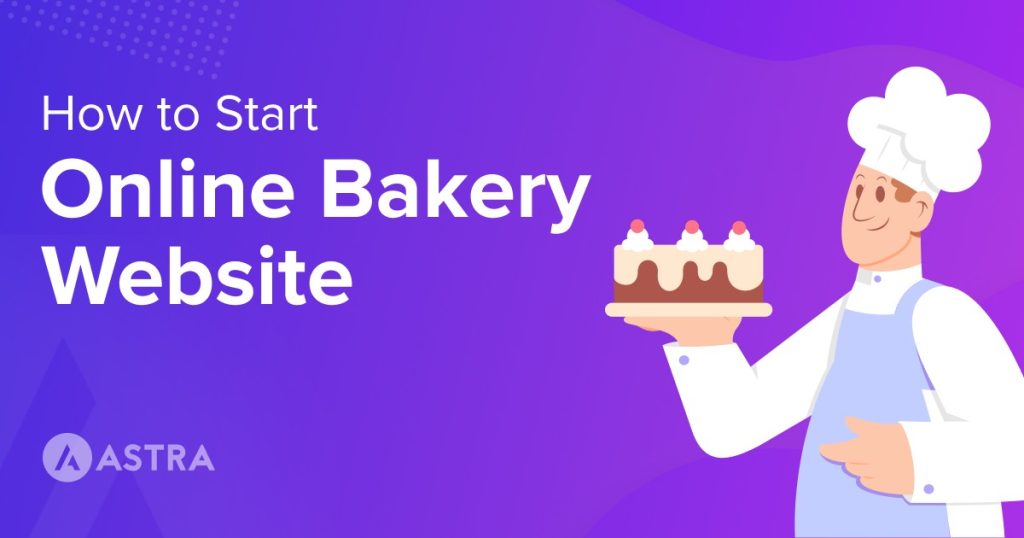





I’m a bakery owner. I don’t have a website for my business. But, after reading your article, It seems building a website for a bakery will be very helpful to reach a wider audience. And your step-by-step guide with pictorial representations gives confidence in building a bakery website. Thank you for sharing such a great tutorial.
So glad to hear that our article has helped you, Jennifer!